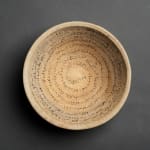Terracotta Incantation Bowl with Aramaic Inscription, 500 CE - 800 CE
Terracotta
15.9 x 6.4 cm
6 1/4 x 2 1/2 in
6 1/4 x 2 1/2 in
X.0552
Further images
The term 'Babylonian demon bowl' is used to describe earthenware vessels found exclusively in various sites of Iran and Iraq, created as forms of both protective and aggressive magic. They...
The term "Babylonian demon bowl" is used to describe earthenware vessels found exclusively in various sites of Iran and Iraq, created as forms of both protective and aggressive magic. They are identified by writing on the interior, and occasionally on the outside, in either Jewish-Aramaic, Syriac, Mandaic or Persian (Pehlevi). Placed in the corners of rooms where demons were believed to sneak in through cracks in the floor and walls, the bowl was buried facedown to lure malevolent spirits inside in order to trap them. The script was presumably an enticement, attracting demons so they would not do harm to persons or property. The open area in the center, combined with the sinuous, flowing script along the flared sides, does give the impression of a swirling vortex. Elegant in its simplicity, powerful in its incantation, this extraordinary bowl is a tangible link to magical practices of the Near East in Late Antiquity.
This is a good example of a magic bowl that is written in Jewish Aramaic.
This type dates to between the 5th and 7th century AD. Th handwriting is generally clear, though there are sections that wer difficult to read from the photograph. Unclear sections are marked by series of dots (..) and one section which was inserted by the scribe abov the line is marked between a pair of shevrons (^ ^). This amulet was writte for a certain Hurmizdad son of Mamy, his wife, sons and daughters who sough protection from supernatural entities that manifest themselves in the form of night and day dreams. These are vanquished by being sealed and bound.
This bowl text also contains two biblical quotations. The first is Zecharia 3:2 that is well known for its protective qualities, especially when recite at night time before retiring, as it is still done as part of the standar daily order of prayer. The second verse is part of Deuteronomy 6:4 that i also found in the same evening prayer and is part of the most fundamenta liturgical formula of Judaism (the 'Shema Yisrael'), the reaffirmation o monotheism.
The translation of the text reads as follows: (1) Sealed and countersealed in the house (2) and dwelling and wife and sons and daughters (3) of Hurmizdad son of Mamy from dreams of the night and dreams of the day. (4) Sealed and countersealed by ... (5) from one hundred and sixty six types of iron .. and by .. (6) sealed and countersealed by seven seals and eight…even the LORD that hath chosen Jerusalem rebuke thee: [is] not this a brand plucked out of the fir …And the LORD said unto Satan, The LORD rebuke thee, O Satan (Zechariah 3:2) knots. Hear O' Israel the LORD our God the LORD is one (Deuteronemy 6:4). (7) Bindings of bindings and knots of knots .. Seal and by ..
This is a good example of a magic bowl that is written in Jewish Aramaic.
This type dates to between the 5th and 7th century AD. Th handwriting is generally clear, though there are sections that wer difficult to read from the photograph. Unclear sections are marked by series of dots (..) and one section which was inserted by the scribe abov the line is marked between a pair of shevrons (^ ^). This amulet was writte for a certain Hurmizdad son of Mamy, his wife, sons and daughters who sough protection from supernatural entities that manifest themselves in the form of night and day dreams. These are vanquished by being sealed and bound.
This bowl text also contains two biblical quotations. The first is Zecharia 3:2 that is well known for its protective qualities, especially when recite at night time before retiring, as it is still done as part of the standar daily order of prayer. The second verse is part of Deuteronomy 6:4 that i also found in the same evening prayer and is part of the most fundamenta liturgical formula of Judaism (the 'Shema Yisrael'), the reaffirmation o monotheism.
The translation of the text reads as follows: (1) Sealed and countersealed in the house (2) and dwelling and wife and sons and daughters (3) of Hurmizdad son of Mamy from dreams of the night and dreams of the day. (4) Sealed and countersealed by ... (5) from one hundred and sixty six types of iron .. and by .. (6) sealed and countersealed by seven seals and eight…even the LORD that hath chosen Jerusalem rebuke thee: [is] not this a brand plucked out of the fir …And the LORD said unto Satan, The LORD rebuke thee, O Satan (Zechariah 3:2) knots. Hear O' Israel the LORD our God the LORD is one (Deuteronemy 6:4). (7) Bindings of bindings and knots of knots .. Seal and by ..





